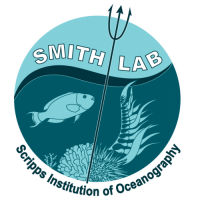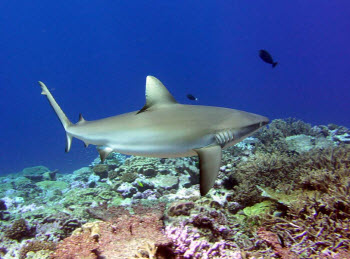


A bohar snapper (Lutjanus bohar), with fangs, at Kingman. These fearless, curious clowns of the reef habitually nip us or our dive gear, and will pick up and chew anything we leave on the reef. Photograph by Jen Smith.
Free of current local human impacts, and without Palmyra’s history of military occupation, Kingman provides a near-pristine reef for study. Near-pristine, because no reef is remote enough to completely escape the fallout from our activities. Kingman, like all the others, is subject to the global effects of rising atmospheric CO2, including increased ocean acidity. There is also the endless stream of plastic trash brought from distant lands by ocean currents and that now accumulates on the windward face of the reef.
Because even near-pristine reefs are now so rare, Kingman has taken on great importance as a research site. Data collected here during the 2005 expedition provided new insights for our understanding of coral reef ecology, some of which will be discussed in future posts. Based on those observations, the reef at Kingman was made the gold standard used when calculating the CHI for coral reefs around the world. (To learn more about the CHI, the Coral Health Index, check out this earlier post.)
Late on Friday the Hanse Explorer brought the research teams the 67 km from Palmyra to Kingman, and yesterday the researchers started their work here. Time is short. There is much to be counted, measured, sampled, and simply observed. But for today—Halloween—for the researchers going overboard at Kingman, it is a treat.
On our first day on Kingman, we dove the western terrace. This the side of the atoll that is sinking. This is also the side where the predominant current runs onto the reef and creates an upwelling. The nutrient-rich upwelling in turn feeds the plankton, which attract everything else. Coral cover is incredible, probably over 60%. There are schools of iridescent ctenophores [comb jellies], and the mantas are all over the place, twisting and turning to feed on all the things floating in the water column. We saw at least ten in just one dive. My dive partner and I were literally surrounded by a wall of big eye jacks.
– Forest Rohwer, head researcher on the Microbe Team
Read more from the field at: http://coralreefsystems.org



